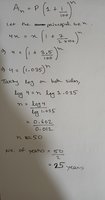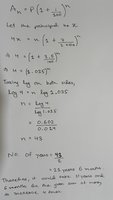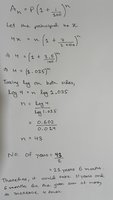You are using an out of date browser. It may not display this or other websites correctly.
You should upgrade or use an alternative browser.
You should upgrade or use an alternative browser.
Please check if my solution is correct for a compound interest problem
- Thread starter msd1997
- Start date
jonah2.0
Full Member
- Joined
- Apr 29, 2014
- Messages
- 534
Beer soaked correction follows.


How long will it take a given sum of money to increase 4 times it's present value when compounded half yearly at 7% rate of interest?View attachment 26697


Harry_the_cat
Elite Member
- Joined
- Mar 16, 2016
- Messages
- 3,693
Jonah has pointed out an error in your calculations which will affect your final answer.
You can always check your final answer yourself, by feeding it back into the expression.
That is, if you put \(\displaystyle n=50\) back into \(\displaystyle (1.035)^n\) you would have got 5.58... not the 4 you should have expected.
Then you can check for calculation errors and hopefully pick up your own mistake!
You can always check your final answer yourself, by feeding it back into the expression.
That is, if you put \(\displaystyle n=50\) back into \(\displaystyle (1.035)^n\) you would have got 5.58... not the 4 you should have expected.
Then you can check for calculation errors and hopefully pick up your own mistake!
[QUO
N=
Thank you! Is this correct solution? Is 21 years and 6 months the correct final answer?
N=
Thank you! Is this correct solution? Is 21 years and 6 months the correct final answer?
Attachments
Jonah has pointed out an error in your calculations which will affect your final answer.
You can always check your final answer yourself, by feeding it back into the expression.
That is, if you put \(\displaystyle n=50\) back into \(\displaystyle (1.035)^n\) you would have got 5.58... not the 4 you should have expected.
Then you can check for calculation errors and hopefully pick up your own mistake!
Thank you!! Can you please tell me if this is the correct answer now?
Attachments
D
Deleted member 4993
Guest
Thank you!! Can you please tell me if this is the correct answer now?
Did you follow the advice-above andJonah has pointed out an error in your calculations which will affect your final answer.
You can always check your final answer yourself, by feeding it back into the expression.
That is, if you put n=50n=50\displaystyle n=50 back into (1.035)n(1.035)n\displaystyle (1.035)^n you would have got 5.58... not the 4 you should have expected.
Then you can check for calculation errors and hopefully pick up your own mistake!
calculate (1.035)21.5 = ?
First, as Subhotosh Khan mentioned, if you had done what was suggested in # 3, you would have seen yourself that your computation is in error.
Second, what is interesting to me is why your computation was in error because your basic logic was correct.
[MATH]n = \dfrac{log(4)}{log(1.035)}.[/MATH] That is an exact answer.
But it is not a practical answer.
[MATH]log_{10}(4) \approx 0.6021.[/MATH]
[MATH]log_{10}(1.035) \approx 0.01494.[/MATH]
[MATH]\dfrac{0.6021}{0.01494} \approx 40.3.[/MATH]
In the old days when we rode an orange-painted mastodon to school, we would have used four or five place logarithm tables and got a good approximation. Nowadays, calculators give logarithms to many significant figures. That means you can get excellent approximations if you never use approximations in intermediate steps.
Second, what is interesting to me is why your computation was in error because your basic logic was correct.
[MATH]n = \dfrac{log(4)}{log(1.035)}.[/MATH] That is an exact answer.
But it is not a practical answer.
[MATH]log_{10}(4) \approx 0.6021.[/MATH]
[MATH]log_{10}(1.035) \approx 0.01494.[/MATH]
[MATH]\dfrac{0.6021}{0.01494} \approx 40.3.[/MATH]
In the old days when we rode an orange-painted mastodon to school, we would have used four or five place logarithm tables and got a good approximation. Nowadays, calculators give logarithms to many significant figures. That means you can get excellent approximations if you never use approximations in intermediate steps.
msd1997, you cannot rename the principal as n because you are still using n as the time. Just keep
using P for the principal:
\(\displaystyle 4P \ = \ P\bigg(1 \ + \ \dfrac{7}{2*100} \bigg)^n \)
I did not rename the principal anywhere.
n is the time, and principal is x.
Maybe, my bad handwriting got you confused.
First, as Subhotosh Khan mentioned, if you had done what was suggested in # 3, you would have seen yourself that your computation is in error.
Second, what is interesting to me is why your computation was in error because your basic logic was correct.
[MATH]n = \dfrac{log(4)}{log(1.035)}.[/MATH] That is an exact answer.
But it is not a practical answer.
[MATH]log_{10}(4) \approx 0.6021.[/MATH]
[MATH]log_{10}(1.035) \approx 0.01494.[/MATH]
[MATH]\dfrac{0.6021}{0.01494} \approx 40.3.[/MATH]
In the old days when we rode an orange-painted mastodon to school, we would have used four or five place logarithm tables and got a good approximation. Nowadays, calculators give logarithms to many significant figures. That means you can get excellent approximations if you never use approximations in intermediate steps.
Thank you so much!
Can you please tell me upto how many digits should i calculate? You have calculated upto 5 digits after decimal point.
Can you please tell me if the final answer is 20 years, 1 month and 24 days?
No. I actually calculated to 4 significant digits and came up with an approximation of 40.3 months. And 1.035 raised to the power of 40.3 is very close to 4. With a modern calculator, you can get better approximations, but they usually have little practical significance.Thank you so much!
Can you please tell me upto how many digits should i calculate? You have calculated upto 5 digits after decimal point.
Can you please tell me if the final answer is 20 years, 1 month and 24 days?
My calculator works to 32 significant digits. Using all the digits gives an answer close to 40.297583368, which is pretty close to 4.3. And 1.035 raised to the power of 40.297583368 is about 3.9999999999998, which is very close to 4.
My point was to use your calculator and worry about how many digits are relevant only at the very end.
Now, the exact time that either 40.3 or 40.297583368 periods represents is a complicated question. How long is a month? Are we taking into account leap years? Using the 40.3 figure, that translates into 40.3 periods times 6 months per period = 240.8 months. Does that make sense? If we count a month as 30 days, we get 20 years and 24 days. If we are off a day or two in a twenty year span does that make any practical difference?
jonah2.0
Full Member
- Joined
- Apr 29, 2014
- Messages
- 534
Beer soaked ramblings follow.
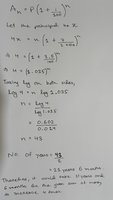
Almost correct. Rounding problems.
You should just let your calculator do its vodoo to avoid misleading results.

In practice, the exact method is rarely used. Instead, we use compound interest for the number of complete interest periods and simple interest (at the stated nominal yearly rate) for the fractional part of the interest period. This method is called the approximate or practical method of accumulating; it yields slightly larger values than does the exact method. For example:
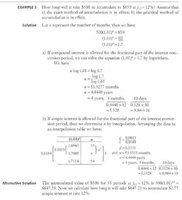

Ah yes, them good old days. I remember them well....
In the old days when we rode an orange-painted mastodon to school, we would have used four or five place logarithm tables and got a good approximation. Nowadays, calculators give logarithms to many significant figures. That means you can get excellent approximations if you never use approximations in intermediate steps.
Thank you! Is this correct solution? Is 21 years and 6 months the correct final answer?

Almost correct. Rounding problems.
You should just let your calculator do its vodoo to avoid misleading results.
msd1997 didn't do any such renaming as far as my beer goggles are concerned. Thou art clearly in error. It warms my heart to think that thou may have been wearing beer goggles yourself to think so. His `x` as he indicated at post # 9, which look to me like a `u`, is clearly anything but an `n` to me beer goggles.msd1997, you cannot rename the principal as n because you are still using n as the time. Just keep
using P for the principal:
\(\displaystyle 4P \ = \ P\bigg(1 \ + \ \dfrac{7}{2*100} \bigg)^n \)
In theory, you may be correct as when we calculate the accumulated value using the compound interest formula for a fractional part of an interest conversion period, we are employing the exact or theoretical method of accumulating.Thank you so much!
Can you please tell me upto how many digits should i calculate? You have calculated upto 5 digits after decimal point.
Can you please tell me if the final answer is 20 years, 1 month and 24 days?
In practice, the exact method is rarely used. Instead, we use compound interest for the number of complete interest periods and simple interest (at the stated nominal yearly rate) for the fractional part of the interest period. This method is called the approximate or practical method of accumulating; it yields slightly larger values than does the exact method. For example:


I did not rename the principal anywhere.
n is the time, and principal is x.
Maybe, my bad handwriting got you confused.
msd1997,
no, I'm not confused, you did rename the principal on the second line of your original post,
post # 1. So, I am not referring to the lines of post # 12. (Had I included post # 12, I could
still state the same truth that you renamed the principal there.)
The first line of post # 1 has the principal as "P," which is standard. And the first line has an "n"
as an exponent for the time. Then, in the second line you have "Let the principal be [not "P," but
a symbol that looks very close to the "n" exponent immediately above in the first line.] By the
time you got to your third line, the symbol (which you claim to be a poorly written "x"), had
morphed into something that was different enough looking as compared to the first two lines.
@ jonah2.0 - This message also applies to you regarding your post to me.
Last edited:
Uh oh. Lookagain is correct of course that the symbols used by the OP are careless. Whether it was an x or an n or a nu in the OP’s handwriting is hard to decipher and why P could not be used consistently prior to cancelling is mysterious, but it has nothing to do with the substance of the OP’s question. That question is valid. The OP’s basic understanding of the mathematics is correct. Why the OP got the incorrect numerical answer has nothing to do with any inconsistency in the use of symbols. Nothing of any pedagogical value about exact and approximate answers is involved in the issue raised by Mademoiselle Vue Encore.msd1997,
no, I'm not confused, you did rename the principal on the second line of your original post,
post # 1. So, I am not referring to the lines of post # 12. (Had I included post # 12, I could
still state the same truth that you renamed the principal there.)
The first line of post # 1 has the principal as "P," which is standard. And the first line has an "n"
as an exponent for the time. Then, in the second line you have "Let the principal be [not "P," but
a symbol that looks very close to the "n" exponent immediately above in the first line.] By the
time you got to your third line, the symbol (which you claim to be a poorly written "x"), had
morphed into something that was different enough looking as compared to the first two lines.
@ jonah2.0 - This message also applies to you regarding your post to me.
There is perhaps some minor social value in pointing out technical errors in the post of helpers. There is no redeeming social value in subjecting questioners to fussy carping about irrelevancies. Was the questioner confused by the notation used? No. Were any helpers confused? No. So the point was to cater to the self-satisfaction od someone who did nothing to help the questioner.
jonah2.0
Full Member
- Joined
- Apr 29, 2014
- Messages
- 534
Beer soaked non sequitur ramblings follow.
It can be very irritating when you're in the middle of something interesting and you realize that your nails need some much needed attention.msd1997,
no, I'm not confused, you did rename the principal on the second line of your original post,
post # 1. So, I am not referring to the lines of post # 12. (Had I included post # 12, I could
still state the same truth that you renamed the principal there.)
The first line of post # 1 has the principal as "P," which is standard. And the first line has an "n"
as an exponent for the time. Then, in the second line you have "Let the principal be [not "P," but
a symbol that looks very close to the "n" exponent immediately above in the first line.]
You might think that "I don't have time for that now or I'll lose my momentum" but those nails just keeps imposing themselves on your conscious mind.By the
time you got to your third line, the symbol (which you claim to be a poorly written "x"), had
morphed into something that was different enough looking as compared to the first two lines.
[/B]But you just keep soldiering on and on and hope it will go away. But it doesn't go away so you drop everything and you realize the clippers are nowhere to be seen.@ jonah2.0 - This message also applies to you regarding your post to me.
Last edited:
@jonah2.0
Your koans fill me with something (is it enlightenment or merely gas). First, the epiphany of the unicycles and now the dilemma of the omnipresent nails and the omniabsent clippers. If you lead Mohammed to the mountain does he still refuse to drink? I am a simple banker, and such philosophical conundrums may be beyond me. I had trouble with the 4 c’s of credit.
Your koans fill me with something (is it enlightenment or merely gas). First, the epiphany of the unicycles and now the dilemma of the omnipresent nails and the omniabsent clippers. If you lead Mohammed to the mountain does he still refuse to drink? I am a simple banker, and such philosophical conundrums may be beyond me. I had trouble with the 4 c’s of credit.
No. I actually calculated to 4 significant digits and came up with an approximation of 40.3 months. And 1.035 raised to the power of 40.3 is very close to 4. With a modern calculator, you can get better approximations, but they usually have little practical significance.
My calculator works to 32 significant digits. Using all the digits gives an answer close to 40.297583368, which is pretty close to 4.3. And 1.035 raised to the power of 40.297583368 is about 3.9999999999998, which is very close to 4.
My point was to use your calculator and worry about how many digits are relevant only at the very end.
Now, the exact time that either 40.3 or 40.297583368 periods represents is a complicated question. How long is a month? Are we taking into account leap years? Using the 40.3 figure, that translates into 40.3 periods times 6 months per period = 240.8 months. Does that make sense? If we count a month as 30 days, we get 20 years and 24 days. If we are off a day or two in a twenty year span does that make any practical difference?
Thank you! But can you please check your maths on the "40.3 multiplied by 6 part"? Isn't it supposed to be 241.8 ? I'm sorry. This question is in an assignment that I need to complete and I want to make sure I do not make any mistakes.
The time required should be 20 years 1 month and 24 days, right?
Thank you!
Beer soaked ramblings follow.
Ah yes, them good old days. I remember them well.
View attachment 26715
Almost correct. Rounding problems.
You should just let your calculator do its vodoo to avoid misleading results.
View attachment 26717
msd1997 didn't do any such renaming as far as my beer goggles are concerned. Thou art clearly in error. It warms my heart to think that thou may have been wearing beer goggles yourself to think so. His `x` as he indicated at post # 9, which look to me like a `u`, is clearly anything but an `n` to me beer goggles.
In theory, you may be correct as when we calculate the accumulated value using the compound interest formula for a fractional part of an interest conversion period, we are employing the exact or theoretical method of accumulating.
In practice, the exact method is rarely used. Instead, we use compound interest for the number of complete interest periods and simple interest (at the stated nominal yearly rate) for the fractional part of the interest period. This method is called the approximate or practical method of accumulating; it yields slightly larger values than does the exact method. For example:
View attachment 26724
View attachment 26725
Thank you!
I forgot to mention that we are not allowed to take calculators to the examination hall. In that case, how many significant digits should i consider for an accurate solution?
msd1997,
no, I'm not confused, you did rename the principal on the second line of your original post,
post # 1. So, I am not referring to the lines of post # 12. (Had I included post # 12, I could
still state the same truth that you renamed the principal there.)
The first line of post # 1 has the principal as "P," which is standard. And the first line has an "n"
as an exponent for the time. Then, in the second line you have "Let the principal be [not "P," but
a symbol that looks very close to the "n" exponent immediately above in the first line.] By the
time you got to your third line, the symbol (which you claim to be a poorly written "x"), had
morphed into something that was different enough looking as compared to the first two lines.
@ jonah2.0 - This message also applies to you regarding your post to me.
You are right about it. I should have kept principal as P. I will keep it in mind for the future.
Thank you!
jonah2.0
Full Member
- Joined
- Apr 29, 2014
- Messages
- 534
Beer induced comment follows.
I am having trouble appreciating the wisdom behind that calculator ban to the examination hall. I just took an anti allergy pill which renders me extremely lazy and somewhat dumb for a few hours so I am unable to give any useful comment for now. I'm sure JeffM could give you better advice about this.... I forgot to mention that we are not allowed to take calculators to the examination hall. In that case, how many significant digits should i consider for an accurate solution?

